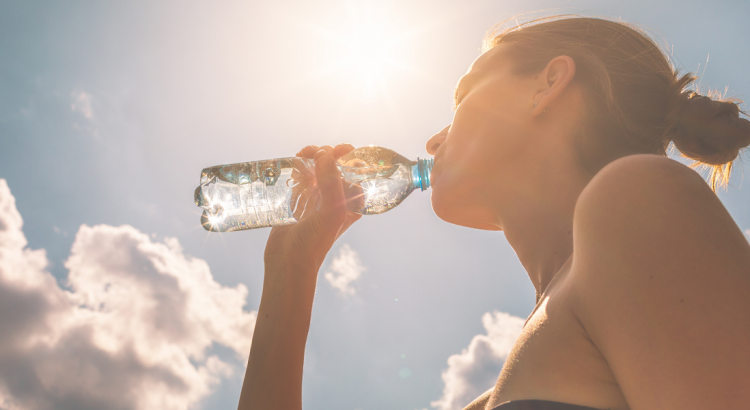Drinking water every day is vital to your health. It prevents dehydration, when your body loses more fluid than it takes in, a condition that can cause unclear thinking, mood changes, temperature changes, constipation, and kidney stones. Regular consumption of water helps to keep a normal body temperature, lubricates and cushions joints, protects sensitive tissue including the spinal cord, and rids the body of wastes through urination, perspiration, and bowel moments.
As we move into the hottest and most humid months of the year, try to drink water throughout your day to prevent becoming dehydrated. Here are a few tips to help meet your daily water intake needs.
- Carry a water bottle with you and refill it throughout the day.
- Freeze water bottles and take them with you for ice-cold water all day long.
- Opt for water when eating out. (Bonus – you’ll save money and reduce calorie intake).
- Add a wedge of lemon or lime to your water to improve the taste.
Remember, the goal is to drink at least eight 8-ounce glasses of water each day. And the National Academies of Science, Engineering, and Medicine suggests that women consume 92 ounces of water per day and men consume 125 ounces per day in the form of fluids and food to maintain desired hydration levels.
The exact amount you need depends on factors including age, gender, activity level, pregnancy, and breastfeeding status. The good news for those who have a hard time sipping water all day is that the foods you eat play a big role in keeping you hydrated. Water-dense foods are not just hydrating to the body, they also provide various nutrients including vitamins and fiber. Keep in mind that these water-dense foods will lose water if they are cooked. To optimize the hydration potential, it’s best to eat them raw or minimally cooked.
Here are the eight most hydrating foods and some ideas on how to enjoy them.
- Cucumbers (95% water-dense) – Get creative about incorporating cucumbers into your diet. Try dipping cucumber slices into dip or humus in place of chips.
- Celery Sticks – With only 15 calories in 4 sticks of celery, there is not much to them except water, vitamins, and minerals. Try stuffing them with peanut butter or tuna salad, which can help reduce your carbohydrate intake if you use celery in place of bread.
- Watermelon – This refreshing summertime fruit has water built into its name – and that is not a coincidence. Watermelon is high in water, low in calories, and a welcome addition to many summer dishes.
- Cantaloupe – This summer melon packs 427 milligrams of potassium, making it a decent source of the nutrient. Potassium is important to hydration – it’s an electrolyte, which means it helps the body balance water content. You can eat cantaloupe solo, or in a fruit salad, or pair it with prosciutto for a sweet and savory snack.
- Strawberries – The sweet, red fruit is an excellent source of vitamin C and incredibly hydrating – with 91% water. Get your fix by serving a strawberry and basil salad or dipping the fruit in melted chocolate for a nutritious dessert.
- Iceberg lettuce – All types of lettuce and greens, like kale and spinach, have high water content, but iceberg lettuce wins as the most hydrating at 95% water by weight. The most obvious way to enjoy it is chopped in a salad, but you can use it in place of a bun on your next burger.
- Tomatoes – With 94% water content and like cantaloupe, they’re a source of potassium, offering 292 milligrams in one medium tomato, they are versatile and delicious. You can enjoy them in pasta sauce, fresh salsa, gazpacho, or simple sliced and sprinkled with a touch of salt and pepper.
- Bell peppers – A low-carbohydrate hydrating food that can be diced to add a crunch to salads, cut into slices as an alternative to chips for scooping hummus or dip, and stuffed for a dinner entrée.
When it comes to water intake, you don’t have to overthink it. If you are eating a diet rich in fruits and vegetables, hitting the hydration mark should not be hard. Follow tried-and-true nutrition advice by aiming for two to three servings of fruit and five or more servings of veggies daily.
If you feel you can benefit from increasing your water intake this month, join the Fitness and Wellness Hydration Intake Challenge.
